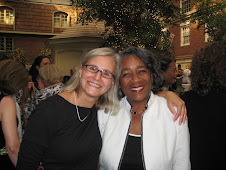Jane Buckner in David
Hyerle's Student Successes with Thinking Maps states that "writing is actually thinking written down." Buckner makes this claim because she believes that many educators feel "writing is just talk written down" (page 78).
That statement equating thinking and writing started me on my quest to explore writing connections in the books that I had received from
NUA. Although I had used or seen many of the strategies modeled, I had not scanned the books with a "writing and thinking" lens. I got some great ideas that I could pass on to teachers who had
specific questions about teaching writing. Below is a summary of my findings:
Student Successes in Thinking MapsBuckner's chapter in
Student Successes in Thinking Maps called “Empowering Students from Thinking to Writing” specifically addresses how to help students write a non-plagiarized, authentic research paper. Buckner advocates the use of the tree map or flee map for
note taking. English 10 teachers had great luck with the flee map last year during the research paper unit to help students organize their research findings before writing their paper.
In addition to tree or flee maps for
note taking, Buckner states that teachers can help students with disorganized papers through a process of “reverse mapping.” Basically, students cut apart their paper and try to fit their sentences into a flee map. Reverse mapping also allows students to see any holes that they have in their paper.
Thinking Strategies for Student AchievementDenise
Nessel’s book,
Thinking Strategies for Student Achievement, has a wealth of writing strategies. Here is the briefest of summaries of writing-relevant chapters:
Cubing (p. 39): Chapter 5 describes this strategy which allows students to think about a topic from multiple perspectives (describe, compare/contrast, associate, analyze, apply, and argue for/against). This strategy increases students' fluency on a topic and helps them learn the cognitive clues that are often used in essay questions.
Freewriting (p. 67): Chapter 9 discusses a long-time favorite strategy for English teachers that involves students writing for a sustained period of time without stopping. This technique is a great tool for generating ideas and overcoming writer's block.
I-Search Reporting (p. 81): Chapter 12 includes a number of follow-up questions that teachers can ask students to make research paper topics relevant to their lives by having students formulate questions that are related to their concerns and pursuits.
Imitation Writing (p. 87): Chapter 13 outlines this strategy which involves taking a known work or famous quotation and substituting words while maintaining the text's structure.
Journal and Learning Logs (p. 101): Chapter 15 includes a number of journal writing prompts not only for English teachers but also for math, social studies, and science logs.
Key Word Notes (p. 109): Chapter 16 details this strategy that many
Edina teachers use for lectures, readings, films and classroom discussions. Key Word Notes is a quick and efficient information gathering strategy if students need to write an essay after a reading selection as part of an exam. To learn about more applications of this strategy, click on "Key Word Notes" under "
NUA Topics Discussed on This Blog."
Paraphrasing (p. 141): Chapter 21 discusses how teachers should start students with paraphrasing of texts that students can’t copy—e.g. videos, the teacher reading aloud. Then students can progress to reading, putting down the text, and taking notes.
Saturation Reporting (p. 171): Chapter 27 discusses this eye witness written report based on intense observations of a certain location and/or event. These reports become detailed, sensory descriptions.
Writing Frames (p. 187): Chapter 30 of Nessel's book summarizes the strategy of using frames (text structures with blanks to be filled in) that is detailed in Writing as Learning by Andrew and Evelyn Rothstein.
Sample Descriptive Writing Lesson: On p. 171, Nessel outlines a writing lesson that incorporates a number of strategies previously mentioned in her book.
Thinking Maps: Tools for LearningDavid
Hyerle's Thinking Maps binder has many ideas for
prewriting and essay organization. The "Teaching" section of the binder shows how each map can be used for
prewriting an essay, and an essay prompt is included. Also, pages 3-17 and 3-24 have writing starter patterns.
If students learn cognitive clues in essay questions, they will be able to select the appropriate Thinking Map for organizing their ideas. For example, Thinking Maps are associated with the following expository text structures:
1) sequence is flow map
2) double bubble is compare and contrast
3) multi-flow is cause and effect
4) circle map or bubble map for describing
5) problem/solution involves multiple maps (circle map to define, double bubble to compare to possible solutions)
Writing as LearningAndrew
Rothstein, Evelyn
Rothstein and Gerald
Lauber's book
Writing as Learning includes a number of strategies to assist with writing across the curriculum. The book discusses how the A to Z Taxonomy can be used both to engage students and to help them organize their ideas for writing. Chapter 7 "Profiles and Frames: Organize Your Writing" and Chapter 9 "Reasons, Causes, Results--The Basis of the Essay" appear to be the most relevant chapters to assist teachers with high school essay writing.
 They then used their group's two or three assigned words to create a skit incorporating the words. Groups performed the skits for the class, and we used the applause meter to determine the winner.
They then used their group's two or three assigned words to create a skit incorporating the words. Groups performed the skits for the class, and we used the applause meter to determine the winner. For homework over the weekend, I assigned creating a Thinking Map that further illustrates their word from 4-square. Students can create any Thinking Map that they want that illustrates or expands on their assigned vocab word. For example, they could make an analogy on a bridge map, define the word with a circle map, describe the word with adjectives in a bubble map, analyze the causes and effects of the word in a multi-flow map. Click on the double bubble map to the left to take the map to full screen to see a comparison of Kola (the vocab word) with coffee that the students and I created quickly as a model in class today.
For homework over the weekend, I assigned creating a Thinking Map that further illustrates their word from 4-square. Students can create any Thinking Map that they want that illustrates or expands on their assigned vocab word. For example, they could make an analogy on a bridge map, define the word with a circle map, describe the word with adjectives in a bubble map, analyze the causes and effects of the word in a multi-flow map. Click on the double bubble map to the left to take the map to full screen to see a comparison of Kola (the vocab word) with coffee that the students and I created quickly as a model in class today.





























